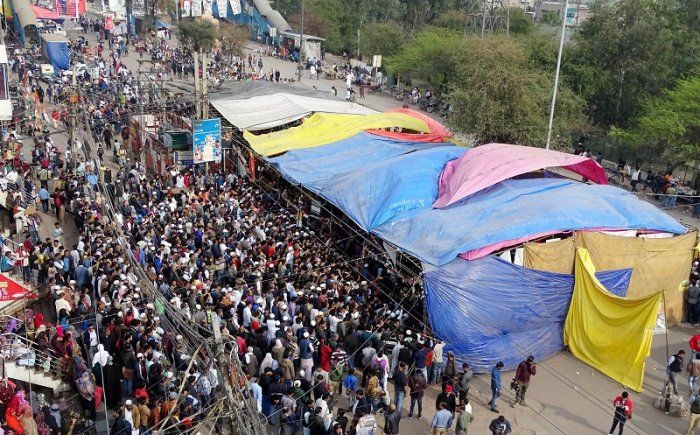Gilles Deleuze, Difference and Repetition, trans. Paul Patton (New York: Columbia University Press 1994), 55–56.
Jantar Mantar is a place that is designated/earmarked by the government to conduct political demonstrations within the capital city; India Gate is a popular tourist destination built as a monument for martyrs of Indian independence, but came to prominence as a site of protest in 2012 as part of the civil society protests against the brutal gang rape and murder of a woman in Delhi; Mandi House is the cultural hub of Delhi, often used to mobilise citizenry for marches to the parliament.
In late 2015, a group of Dalit student-activists, including Rohith Vemula, were accused by the UoH administration for partaking in anti-national activities. What led to the suspension of these students from the university was an event organised by Ambedkar Students’ Association (ASA)—a political outfit of Dalits and other minority communities in UoH—condemning the extra-judicial killing of Yakub Memon, an alleged terror suspect in the infamous ‘Mumbai bomb blasts’ in the wake of the demolition of the historic Babri Masjid by Hindu extremists. ASA had organised a public meeting and film screening highlighting the procedural lapses in the judicial execution of Memon on the one hand, as well as an attempt at foregrounding the ethical stand against capital punishment endorsed by B.R. Ambedkar.
I have elsewhere written about the emergence of a new politics emerging from minoritarian becoming vis-à-vis the Left-dominated discourse on politics. See ➝.
This is evident in the way ASA had affiliated with the mainstream Left student organization SFI (Students’ Federation of India).
“Neel Salam, Jai Bhim” can be translated as “Blue Salute, Victory to Bhim.” Bhim here refers to both, B.R. Ambedkar and the Buddhist genealogy of Dalit politics. The Blue Salute draws from Ambedkar’s conversion to Buddhism and the new path (Navayana) that he envisioned. These slogans are counter to the dominance of Lal Salam (or Red Salute) which is central to the enactment of Left political mobilization.
Jyotirao Phule (1827–1890) was a radical social reformer and anti-caste crusader. Savitribai Phule (1831–1897) had along with Fatima Sheikh initiated several concrete measures for the emancipation of women through education and organisation, such as the setting up of a school for girls in 1848. The exact dates of Sheikh’s birth or demise are not recorded publicly yet.
The Batla House encounter in 2008 was covered by constant live news telecasts and press coverage. Aerial shots were used as a means of conveying the congested nature of the “ghetto.” Since then, Batla House has become synonymous with the “potential Muslim terror” narrative within the spatial imagination of the city.
HT Correspondent, “A blow-by-blow account of Jamia protest in last 24 hrs over Citizenship Act,” Hindustan Times, December 16, 2019, ➝.
See ➝.
I draw this term from Walter Benjamin’s usage in his essay “Goethe’s Elective Affinities,” published in Walter Benjamin: Selected Writings, 1: 1913-1926, eds. Marcus Bullock and Michael W. Jennings (Cambridge: Harvard University Press, 2004).
Conversion is used here in both the phenomenological and historical sense. In a phenomenological sense, it implicates a certain exteriority that is central to the deep interiority of existence. In this specific context, it demands a process of deindividuation where the certainty of the coherent individual becomes an impediment in terms of embodying the event. In a historical sense, the word conversion is evoked in order to trace the legacy of Ambedkarite politics. Ambedkar’s preferences of transformative politics over the so-called revolutionary politics resonates with the present political reconfiguration that is central to the argument of this essay. It evokes the historical memory of Ambedkar’s decades-long ruminations on religious conversion as an emancipatory act, his thoughts on various religions in this process, and his conversion to Buddhism on October 14, 1956 (along with half a million Dalits). Ambedkar did not convert to an established religion of Buddhism; rather, he carved out a new pathway within Buddhist thought, calling it Navayana (new vehicle), which revitalized the inherent egalitarian principles of Buddhism and called for a closer integration of the individual and the social world.
They are fractal images of the becoming-political of the world; they exceed topological imagination.
The author would like to thank Sneha Ragavan, Shveta Sarda, Jeebesh Bagchi, and Bhagwati Prasad for their camaraderie, conversations, and the collective experience that formed the building blocks of this essay.
Architectures of Education is a collaboration between Nottingham Contemporary, Kingston University, and e-flux Architecture.
